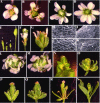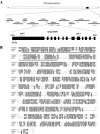PAUSED, a putative exportin-t, acts pleiotropically in Arabidopsis development but is dispensable for viability
- PMID: 12913148
- PMCID: PMC181277
- DOI: 10.1104/pp.103.023291
PAUSED, a putative exportin-t, acts pleiotropically in Arabidopsis development but is dispensable for viability
Abstract
Exportin-t was first identified in humans as a protein that mediates the export of tRNAs from the nucleus to the cytoplasm. Mutations in Los1p, the Saccharomyces cerevisiae exportin-t homolog, result in nuclear accumulation of tRNAs. Because no exportin-t mutants have been reported in multicellular organisms, the developmental functions of exportin-t have not been determined. Here, we report the isolation and characterization of two Arabidopsis exportin-t mutants, paused-5 and paused-6. The mutant phenotypes indicate that exportin-t acts pleiotropically in plant development. In particular, paused-5 and paused-6 result in delayed leaf formation during vegetative development. The two paused mutations also cause the transformation of reproductive organs into perianth organs in the hua1-1 hua2-1 background, which is partially defective in reproductive organ identity specification. The floral phenotypes of hua1-1 hua2-1 paused mutants resemble those of mutations in the floral homeotic gene AGAMOUS. Moreover, paused-5 enhances the mutant phenotypes of two floral meristem identity genes, LEAFY and APETALA1. The developmental defects caused by paused mutations confirm the important roles of exportin-t in gene expression in multicellular organisms. In addition, a paused null allele, paused-6, is still viable, suggesting the presence of redundant tRNA export pathway(s) in Arabidopsis.
Figures







Similar articles
-
PAUSED encodes the Arabidopsis exportin-t ortholog.Plant Physiol. 2003 Aug;132(4):2135-43. doi: 10.1104/pp.103.023309. Plant Physiol. 2003. PMID: 12913168 Free PMC article.
-
Two RNA binding proteins, HEN4 and HUA1, act in the processing of AGAMOUS pre-mRNA in Arabidopsis thaliana.Dev Cell. 2003 Jan;4(1):53-66. doi: 10.1016/s1534-5807(02)00399-4. Dev Cell. 2003. PMID: 12530963 Free PMC article.
-
Expression and characterization of rice putative PAUSED gene.Acta Biochim Biophys Sin (Shanghai). 2008 Oct;40(10):893-900. Acta Biochim Biophys Sin (Shanghai). 2008. PMID: 18850055
-
The poetry of reproduction: the role of LEAFY in Arabidopsis thaliana flower formation.Int J Dev Biol. 2012;56(4):207-21. doi: 10.1387/ijdb.113450ns. Int J Dev Biol. 2012. PMID: 22451042 Review.
-
Coming into bloom: the specification of floral meristems.Development. 2009 Oct;136(20):3379-91. doi: 10.1242/dev.033076. Development. 2009. PMID: 19783733 Review.
Cited by
-
Genome-wide investigation of the role of the tRNA nuclear-cytoplasmic trafficking pathway in regulation of the yeast Saccharomyces cerevisiae transcriptome and proteome.Mol Cell Biol. 2013 Nov;33(21):4241-54. doi: 10.1128/MCB.00785-13. Epub 2013 Aug 26. Mol Cell Biol. 2013. PMID: 23979602 Free PMC article.
-
Nucleo-cytoplasmic transport of proteins and RNA in plants.Plant Cell Rep. 2011 Feb;30(2):153-76. doi: 10.1007/s00299-010-0928-3. Epub 2010 Oct 20. Plant Cell Rep. 2011. PMID: 20960203 Free PMC article. Review.
-
tRNA biology charges to the front.Genes Dev. 2010 Sep 1;24(17):1832-60. doi: 10.1101/gad.1956510. Genes Dev. 2010. PMID: 20810645 Free PMC article. Review.
-
The Arabidopsis nuclear pore and nuclear envelope.Arabidopsis Book. 2010;8:e0139. doi: 10.1199/tab.0139. Epub 2010 Oct 7. Arabidopsis Book. 2010. PMID: 22303264 Free PMC article.
-
Nucleo-cytoplasmic partitioning of proteins in plants: implications for the regulation of environmental and developmental signalling.Curr Genet. 2003 Dec;44(5):231-60. doi: 10.1007/s00294-003-0444-x. Epub 2003 Oct 2. Curr Genet. 2003. PMID: 14523572 Review.
References
-
- Arts GJ, Fornerod M, Mattaj IW (1998) Identification of a nuclear export receptor for tRNA. Curr Biol 8: 305–314 - PubMed
-
- Bollman KM, Aukerman MJ, Park M-Y, Hunter C, Berardini TZ, Poethig RS (2003) HASTY, the Arabidopsis ortholog of exportin 5/MSN5, regulates phase change and morphogenesis. Development 130: 1493–1504 - PubMed
-
- Bowman JL, Alvarez J, Weigel D, Meyerowitz EM, Smyth DR (1993) Control of flower development in Arabidopsis thaliana by APETALA1 and interacting genes. Development 119: 721–743
Publication types
MeSH terms
Substances
Grants and funding
LinkOut - more resources
Full Text Sources
Molecular Biology Databases

